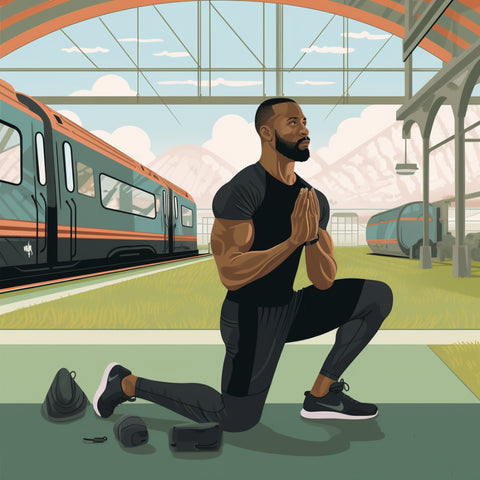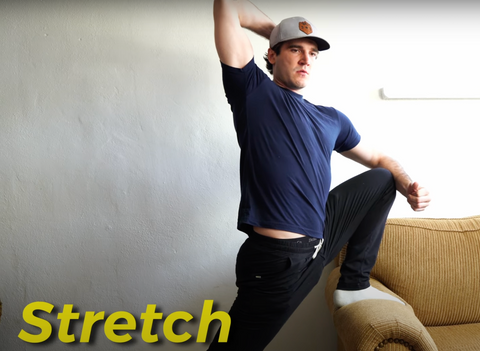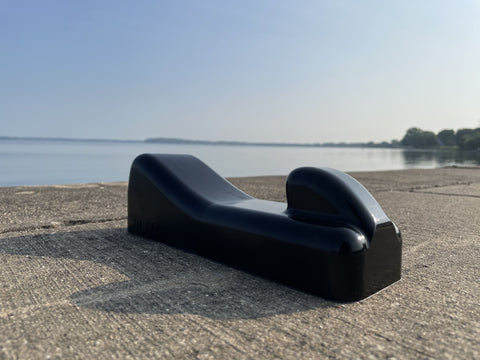If anyone’s ever told you that you can’t stretch your Psoas, they’re flat-out wrong.
A good Psoas stretch happens when you can reeeaaally lengthen your Psoas–counteracting all the tightness that happens from sitting too long.
We’ve all had to sit for hours on end before–whether in the classroom or at the office–and unfortunately, this can lead to a very angry Psoas muscle.
At Back Muscle Solutions, we know how that a stiff Psoas muscle can lead to serious back pain. That’s why we’re here to share 6 Psoas stretches to shut down your back pain. And the great news is: You can start this Psoas stretch routine TODAY and start feeling results ASAP.
Let’s dive into the details and get your Psoas feeling happy again!
Stuff to Know Before the Psoas Stretch

1) First things first: If you’re wondering HOW you know that you need a Psoas stretch, scroll down further for all the details. I cover the typical symptoms you’ll experience when you need a Psoas stretch.
2) Also, it’s super important to say that BEFORE you get in a good Psoas stretch, it’s gonna be critical for you to massage your Psoas muscle. First massage; then stretch!
So, if you need details on Psoas massage–how to, devices, and tools–scroll down a little later in this article, and you’ll see the BEST Psoas massage that I recommend!
Now, let’s get into all the details about Psoas stretch!
6 Best Psoas Stretches That'll Shut Down Your Back Pain
Your Psoas is a hip flexor muscle–located in the front of your body. But when it gets ticked off, it likes to wage war on your lower back–especially after you’ve been sitting too long–which, who doesn't these days?!
So, if you’re moaning and groaning every time you stand up from the couch–try these 6 Psoas stretches for quick pain relief!
Psoas Stretch #1: Standing Psoas Stretch

1) Elevate your right foot by placing it on a stool, chair, or sofa–think knee-to-hip high.
(Higher is harder–so base it on how deep of a Psoas stretch you need.)
2) Now, lean forward, pressing your torso into your right knee and elongating the back leg.
(It’s the elongation of this back leg that’ll really stretch out and lengthen your Psoas!)
3) Engage your glute to help your hip flexors relax.
4) Floss or pulse forward and backward to get that really good Psoas stretch!
5) Repeat on the other side.
Level up: From this position, using the arm on the same side as your back leg, grab behind your neck–with your elbow pointing up in the air.
As you do this, grab your knee with your opposite arm, and rotate your body, so it is slightly turned toward the side of the straight leg.

Psoas Stretch #2: Kneeling Lunge
1) On a yoga mat, go into a half-kneeling position.
2) Your left knee should be on the ground directly in line with your hip.
3) The right knee should be in front of you, forming a 90-degree angle with your right foot, which should be flat on the floor.
4) Using your glutes, rock your body forward slightly at the hips.
5) Hold for 30 seconds.
6) Then, return to the starting position.
7) Repeat on the other side.
Psoas Stretch #3: Low Lunge With a Twist
1) On a yoga mat, go into a low lunge position.
2) With both hands on the floor, bring your right knee forward–up near your shoulder, placing your right foot flat on the floor.
3) Your left leg should be stretched behind you–with your left knee touching the floor.
4) Lift your right arm up toward the ceiling. As you do this, your chest will open.
5) Hold for 20 seconds.
4) Then, return to the starting position.
5) Repeat on the other side.
Psoas Stretch #4: Glute Bridge
1) Lay on your back on a yoga mat.
2) Place both of your feet flat on the floor–with both knees bent.
3) Drive your hips up to the ceiling, using your glutes to propel this motion.
4) Then, slowly lower the hips back down to the starting position, and repeat.
Psoas Stretch #5: Table Stretch
1) Find a stable surface, such as a table or bench, and lie down on your back.
2) Then, bring the outer leg over the edge of the table, letting it hang over the edge.
3) You’ll feel gravity provide you with a good Psoas stretch!
Psoas Stretch #6: Camel Pose
1) Kneel down on a yoga mat, allowing your buttocks to rest on your heels.
2) Now, place both hands on your hips.
3) Using your glutes, raise your buttocks off your feet to bring your hips just above your knees–still in a kneeling position.
4) Now, arch your back.
5) Then, reach both hands behind you to hold your feet.
6) Hold for 30 seconds.
7) Return to the starting position, and repeat.
How a Good Psoas Stretch Can Help You Cry It Out
Ever feel tension in your body for no apparent reason?
Sometimes, our bodies hold onto emotion–especially from traumatic events. And the Psoas is one of the muscles that really likes to hang on to that tension!
This is because it actually helps you get into fetal position–which is a naturally protective position for us when we’re under threat.
In this way, when you use massage tools and devices for Psoas release and follow it up with a good Psoas stretch, you’re actually releasing tension from trauma–not only caring for your body but also your emotions!
Crazy, right?
To learn more about the Psoas’s connection to trauma and emotion, check out this article, where we spell it all out:
“Psoas Release Guide For Pain & Trauma Relief”
Psoas Stretch While Sleeping: How To
Wondering how to continue all that good Psoas stretching into the night? Try out these positions for a perfect Psoas stretch while sleeping.
1) Knee towards your chest
2) Fetal position
We cover all the details about these Psoas stretch positions in our article:
“How to Stretch Psoas While Sleeping”
Psoas Massage BEFORE Psoas Stretch
Unfortunately, you can't get away from sitting in our culture...whether it's at your computer for work, on couch watching TV, or even grabbing a coffee with a friend.
So, if you can't stop sitting, how do you stop the pain from sitting? In other words, how do you stop Psoas pain for good?
A good Psoas stretch is just part of the equation.
As I mentioned above, before stretching a tight, angry Psoas, I recommend calming it down with a massage first for ultimate Psoas release. Stretching an angry muscle doesn’t usually lead to the best results. (Think about stretching a frozen bungee cord, and that's about how effective a cold stretch is.)
You can go to your local masseuse and explain to them that you think your Psoas has been acting up!
For me personally, getting a massage once a month isn't quite enough to stop my back pain entirely. That's why I prefer an at-home, 24/7 option.
Not a ton of lower back massagers reach the Psoas muscle unfortunately. It's just one of those hard-to-reach muscles.
That's why I recommend the QL Claw.
The QL Claw is an at-home back massage device that’s designed to hit all 5 muscles that tend to clobber your lower back with their anger issues. And naturally, the Psoas is one of these muscles.
With the QL Claw, I know that, even if I have to sit for work or life, I have a quick way out of the pain. I can literally feel it reaching the muscles and providing relief.
For Psoas release, you actually need to lie down on The Claw on your stomach because you can best hit your Psoas from the front.
Another cool detail about The Claw is that it has two unique sides:
1) The smaller end: The Trigger
2) The larger end: The Ramp
Both sides work to massage different muscles, and today, we’re going to use the RAMP to massage your Psoas.
Here’s how to do a Psoas massage using the QL Claw:


1) First, let’s find your Psoas. If you make a line from your belly button to your bony hip bone on either side, your Psoas muscle can be found right in the middle.
2) Place The Claw on the ground, and lie down on it–stomach-first. The Claw should be right on the waistline.
3) Lean your body toward the ramp end of The Claw–finding your Psoas. You’ll feel it as a tender place right between your belly button and bony hip bone.
4) On the working side, place your toes on the ground. Use them to lift your leg off the ground, and rock it to the right and left in order to get a good Psoas massage.
5) As you massage, breathe deeply and slowly–pushing The Claw out on the inhale and sinking into The Claw on the exhale.
6) Massage your Psoas on each side for 2 minutes, 3 times a day, and for 3 days.
After three days, your Psoas should be lengthened and happy–ready for those Psoas stretches we talked about earlier!
Want video instructions to help your Psoas massage? Check out the video below:
“Psoas Release”
See what people are saying using the QL Claw:


What is the Psoas?

How to Find Your Psoas
1) Place your thumbs on your belly button.
2) Then, reach your pinkies down to your hip bone.
The line from your thumb to your pinky covers the location of your Psoas!
What Does Your Psoas Do?
Your Psoas muscle is the guy at the party who jumps around between friend groups and wants everyone to get along. That’s because your Psoas literally connects your upper body and lower body.
The Psoas is a hip flexor muscle that connects from your lower back bones down to your upper thigh bone.
How Do I Know I Need to Stretch My Psoas?
Chances are–you're here because somewhere along the way, you got skeptical of your Psoas.
Maybe you heard this from a massage therapist or a chiropractor or doctor. Maybe you did some research on your own.
But either way–let’s get clear on how you can KNOW that your Psoas needs a good stretch.
Ever hear someone get up from sitting on a couch or chair and groooaaan??! Has that person been you? If so, a Psoas stretch might be just the thing you need.
Here’s why:
Because we tend to sit for…well…most of our lives, the Psoas ends up getting the short end of the stick. Quite literally.
Your Psoas gets shorter as a result of being bent in a sitting position. Imagine keeping your arm bent at a 90-degree angle throughout the entire day. Obviously, your bicep would feel super sore by the end of the day.
The Psoas is a little less obvious, but the same concept applies.
Most people feel Psoas pain not actually when they sit but more so when they stand up right after sitting.
It’s like trying to straighten out a bent, frozen bungee cord.
Obviously, that wouldn’t go well. And that’s exactly how your psoas feels when you suddenly straight and lengthen it after sitting for hours on end.
Check Out Our Best Psoas Stretch Resources
It’s our mission to make the BEST back pain resources on the planet.
A tall order, we know–but we work hard to make that happen.
If you found this article helpful, and you want to learn more about Psoas stretch, massage, and strengthening–check out the resources below:
Psoas Videos
“The Key To Low Back Pain Is Often Releasing The Psoas Muscle”
“What Does Psoas Release Feel Like? (part 1)”
“What Does Psoas Release Feel Like? (Part 2)”
Psoas Articles
“Can Hip Flexors Cause Back Pain? HECK YES: Here’s Why!”
“Psoas Release Guide For Pain & Trauma Relief”
Psoas Stretch FAQs
How do you release the Psoas muscle?
To release the Psoas muscle, you’ll need to start with a Psoas massage. I recommend purchasing an at-home massage tool for Psoas release, such as the QL Claw.
What are the symptoms of a tight Psoas?
If you’re sitting for long periods of time and then stand up to feel that little ache in your lower back–chances are, your Psoas is shortened, tight, and angry.
What is the best stretch for the Psoas muscle?
One of the best Psoas stretches is the standing Psoas stretch–the first one I talk about in this article.
Where do you press for Psoas release?
To find your Psoas, feel for a tender area between your belly button and hip bone.
Is walking good for the psoas?
Yes! Walking is a great solution for a tight Psoas because it helps keep your Psoas loose and stretched.
How long does it take to release Psoas?
Use the QL Claw for a Psoas release for 2 minutes a side, 3 times a day, 3 days.
How do you sleep with Psoas pain?
For a good Psoas stretch when sleeping, I recommend pulling one knee to your chest–or the fetal position. Both of these will help relax your Psoas.
[2] Davies, Clair, and Amber Davies. The Trigger Point Therapy Workbook: Your Self-Treatment Guide for Pain Relief. 3rd ed., New Harbinger Publications, Inc., 2013.



